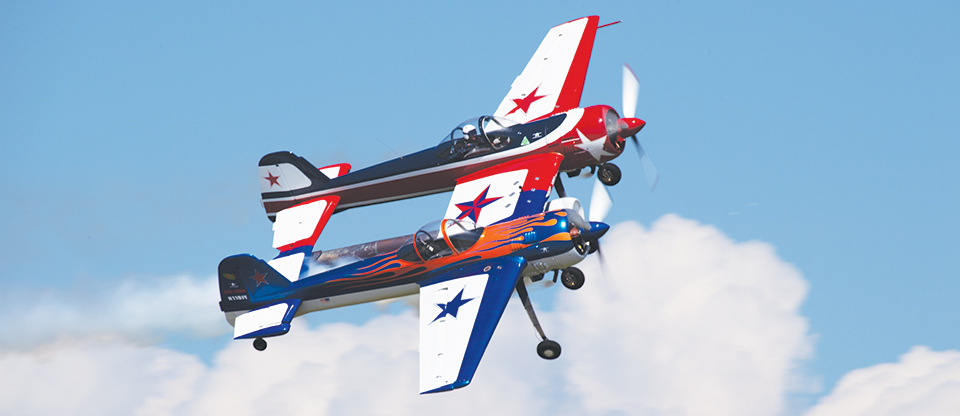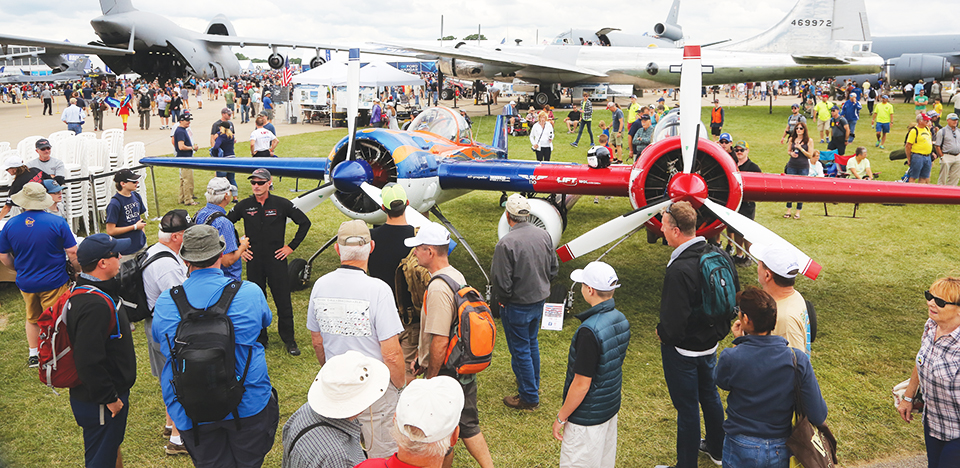Two Times 55 Equals 110
Twin Yak is a one of a kind
By Randy Dufault
July 27, 2018 - As often happens during a hangar flying session, some interesting, possibly bizarre, idea comes to the surface. So was the case when air show pilot Jeff Boerboon, EAA 363600, and a few friends considered what might happen when two identical, high-performance aerobatic airplanes came together as one.
Jeff already owned a Yakovlev Yak-55 and knew of another formerly flown by friend Chad Bartee, EAA 603397.
Friend, mechanic, and builder Dell Coller, EAA 683852, commissioned some concept art so the group could see what the final product of the two Yaks could look like.
“Once we had the drawings we got more excited about it and finally got to a point where we decided to really do this thing for real,” Dell said.
The Yak-110 was born with Jeff’s airplane slated to be the left side.
“We knew the whereabouts of the right airplane, the one Chad had owned previously, and it turns out [it] was available to be purchased. So we secured the two airplanes and brought them together in the hangar. The first step was just to put the two next to each other and see if this was really going to make sense.
“Turns out, it looked like it was going to work.”
Design work began for the new structures and how the controls and other aircraft systems would tie together.
Working from detailed measurements and a laser scan of the Yak’s wing attach fittings, a CAD design for the new wing center section evolved. From the design, the team had plywood versions of the parts cut with a water jet. After gluing the wooden parts together into a full-sized mock-up, test fitting commenced.
“Everything was close, but there were a couple of pieces we needed to make some adjustments on,” Dell said. “So we made those adjustments in the computer model and actually cut a second mock-up from plywood and put that in.
“Everything fit perfectly the way we needed it. The distance between the spinners and the rudders was the same so we knew we weren’t toed in or toed out between the two fuselages.”
Now with a high level of confidence in the design, CNC machining of the center section components commenced. With the exception of the skins, all the components are milled from solid billets of aluminum.
“A similar process was used for the tail since the two elevators were tied together,” Dell said. “Obviously those are much smaller components back there.”
The lengthy elevator did require some stiffening. A trim tab, something the Yak-55 does not have, provides additional control options for both aerobatics and for positioning flights.
Controls were the next challenge after completion of the structural work. According to Dell, the effort was surprisingly simple due to how Yakovlev laid out the original design. Aircraft systems were a little more complicated.
“We completely gutted every wire and every bit of plumbing from the firewalls back,” Dell said. “We have new instrument panels and a new electrical system.
“We converted the fuel system and air system components to be operated electrically so we had just one big wire bundle from the right to the left side. Everything is controlled with switches on the panel,” he said.
Although both cockpits contain a seat, only the left side has controls. The right side is a dedicated passenger seat or luggage compartment, depending on the need.
Test flights commenced without the jet engine. The plane was solid so the team moved on to the next phase.
The design engineered mounts for the jet into the center section so installation just required construction of the engine inlet, cowl, and jet tube. Test flights again confirmed all the systems worked well together.
When asked about the finishes the team settled on, Dell said, “I think it tells the story of bringing two airplanes together to make them one. The left side and the right side have different paint schemes, but they complement each other.”
Ultimately, the conjoined airplane performed beautifully.
“It’s exceeded every expectation we had,” Dell said. “It handles every maneuver we’ve tried really well. It’s a confident, inspiring airplane, and we’ve really just begun to scratch the surface of what it should be capable of doing.”



